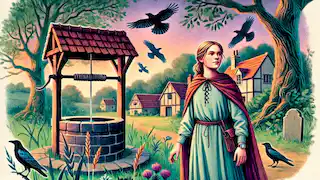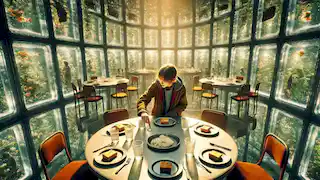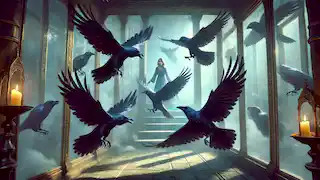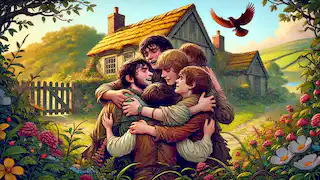The Seven Ravens
Reading time: 9 min

About this story: The Seven Ravens is a Fairy Tale from Germany set in the Medieval This Simple tale explores themes of Redemption and is suitable for All Ages. It offers Moral insights. A tale of redemption and family love from Germany.
Once upon a time, there was a man and a woman who had seven sons but longed to have a daughter. Finally, their wish was granted, and a little girl was born. The joy was great, but the child was small and weak, and her parents feared she might not survive. They decided to baptize her immediately, and so the father sent the seven boys to fetch water from the well for the baptism.
The boys were in such a rush to get the water that they all wanted to be first. In their haste, they dropped the jug into the well and stood there not knowing what to do. They were too afraid to return home without the water, and they lingered around the well, arguing among themselves. Time passed, and when they didn’t come back, their father grew impatient. “Where are those boys?” he exclaimed angrily. “I bet they are playing around again and have forgotten what I sent them for!” He was so frustrated that he cried out, “I wish they would all turn into ravens!”
No sooner had he spoken the words than he heard the flapping of wings above him. Looking up, he saw seven black ravens flying away into the sky. His curse had been fulfilled. The man was grief-stricken, but there was nothing he could do to reverse his words. His sons were gone, and now all he had was his frail little daughter.
The parents did all they could to forget their loss, and the little girl, who soon grew stronger and healthier, brought them much joy. They took great care of her and shielded her from the truth about her brothers. However, the girl was always curious about the strange whispers she sometimes overheard from other villagers. “She’s lovely, but it’s a pity about her brothers,” they would say. But when she asked her parents, they would quickly change the subject or tell her it was nothing.
One day, when she was older, she overheard a conversation that changed everything. An old woman in the village, unaware of who she was, mentioned to another, “You know, it was her fault that her brothers were turned into ravens.” The girl’s heart sank, and she rushed home to confront her parents.
Tearfully, they admitted the truth. The girl was filled with sorrow and guilt, knowing that it was because of her that her brothers had been cursed. Determined to make things right, she resolved to find her brothers and bring them home. She begged her parents for their blessing and set out on her journey with nothing but a small ring her parents had given her, a loaf of bread, a jug of water, and a little chair for resting.
The brave girl wandered far and wide, seeking any sign of her lost brothers. She traveled until she reached the edge of the world, where the sun, moon, and stars lived. First, she went to the Sun, but it was too hot and fierce. The girl was scorched by its heat and fled in terror. Then, she made her way to the Moon, but the Moon was cold and frightening, and when it saw her, it exclaimed, “I smell the flesh of humans!” The girl ran away before the Moon could harm her.
Finally, she arrived at the stars, and they were kind to her. They offered her comfort and told her that the seven ravens lived beyond the glass mountain. The stars gave her a chicken bone, telling her it was the key to the mountain and that without it, she would never be able to enter.

The girl took the bone and continued her journey. When she reached the glass mountain, she found a massive gate that was locked. She pulled out the chicken bone, but to her dismay, it had disappeared. Determined not to give up, she took a knife and cut off one of her fingers, using it as a key to open the gate. The door creaked open, and she entered the mountain.
Inside the mountain, she found a dwarf who asked her what she was seeking. “I’m looking for my brothers, the seven ravens,” she replied. The dwarf said, “The masters of this house are not here, but you may wait for them.” He showed her to a chamber where a table was laid out with seven plates and seven cups. The girl ate a small piece of bread from each plate and took a sip from each cup. Into the last cup, she dropped the ring her parents had given her.

Soon after, she heard the flapping of wings, and the seven ravens returned. They sat down to eat and drink, but as they picked up their cups, they noticed something strange. “There is a human ring in my cup,” said one of the ravens. Then, looking closer, another raven recognized the ring and exclaimed, “It’s our sister’s ring! She must be here and trying to save us!”
At that moment, the girl stepped out from the shadows. When the ravens saw her, they were overjoyed. As soon as they realized it was their sister who had come to free them, the curse was broken. The ravens turned back into boys, and they all embraced one another, weeping with joy and relief.

Together, the siblings returned home, where their parents rejoiced at the sight of all their children. The family was reunited at last, and they lived happily ever after.

*
This version of "The Seven Ravens" captures the classic themes of redemption, bravery, and family love that run through many German fairy tales. The girl’s determination to save her brothers, even at great personal cost, highlights the importance of selflessness and courage.
Characterization and Themes
In this fairy tale, the girl represents innocence and determination, but also guilt and responsibility. She feels it is her fault that her brothers were cursed, and her journey is as much about redeeming herself as it is about saving them. This theme of guilt and atonement is common in many traditional tales, where characters must undergo great trials to make things right.
Similarly, the transformation of the brothers into ravens illustrates the unintended consequences of anger and frustration. Their father’s careless curse leads to a lifelong burden for his children. Yet, the family is ultimately reunited, and love triumphs over the curse. This shows that even in the darkest of circumstances, hope and perseverance can lead to redemption.
Symbolism and Imagery
The imagery of the glass mountain is particularly significant in this story. The mountain, impenetrable and distant, represents the barriers that the girl must overcome, both literal and metaphorical, to save her brothers. Her willingness to sacrifice her finger to open the gate emphasizes the themes of self-sacrifice and determination.
The ravens, too, are symbolic. In many cultures, ravens are seen as messengers between the worlds of the living and the dead, or as omens. In this tale, they are a symbol of the boys’ transformation, a state of limbo that reflects the tension between life and death, human and animal, and curse and freedom. Their transformation back into boys represents the return of order and the resolution of the story’s conflict.
Cultural Context
This story, like many from the Brothers Grimm, reflects the values and concerns of rural German society in the 19th century. The focus on family, redemption, and moral lessons would have resonated deeply with the audiences of the time. Furthermore, the harsh conditions of life, represented by the girl’s difficult journey and her encounters with the sun, moon, and stars, reflect the struggles that many people faced in their day-to-day lives.
Yet, there is also an element of magic and the supernatural that provides hope. Despite the challenges, the girl is aided by the stars, and the supernatural world ultimately helps her achieve her goal. This balance of realism and fantasy is a hallmark of many fairy tales, where the impossible becomes possible through courage, faith, and perseverance.
The Importance of Family
At its heart, "The Seven Ravens" is a story about family. The girl’s journey is motivated entirely by her desire to reunite with her brothers, and the resolution of the story hinges on the family being brought back together. This reflects the importance of family ties in traditional societies, where the family was often the primary source of support and identity. The father’s curse, though made in anger, is undone by the love and dedication of his daughter, emphasizing that love can overcome even the deepest of mistakes.
Conclusion
"The Seven Ravens" is a timeless tale that speaks to universal themes of sacrifice, love, and redemption. It reminds us that even in the face of overwhelming odds, determination and love can lead to miraculous outcomes. The girl’s journey is one of both external trials and internal growth, as she moves from guilt and fear to courage and action. The ultimate message of the story is one of hope: no matter how dark the circumstances, there is always a path to redemption and reunion.
The Seven Ravens: A Reflection on Guilt and Redemption
The moral lessons in "The Seven Ravens" extend beyond the obvious themes of love and family. At its core, the story reflects on the nature of guilt and the ways in which individuals seek to make amends for perceived wrongs. The girl’s sense of responsibility for her brothers’ fate drives her to extraordinary lengths to redeem herself, even though the curse was not directly her fault. This internal struggle mirrors the conflicts faced by many in their quest for personal redemption.
In conclusion, the story leaves us with a powerful message about the transformative power of love, the importance of perseverance, and the ways in which individuals can find redemption even in the most difficult of circumstances.


















